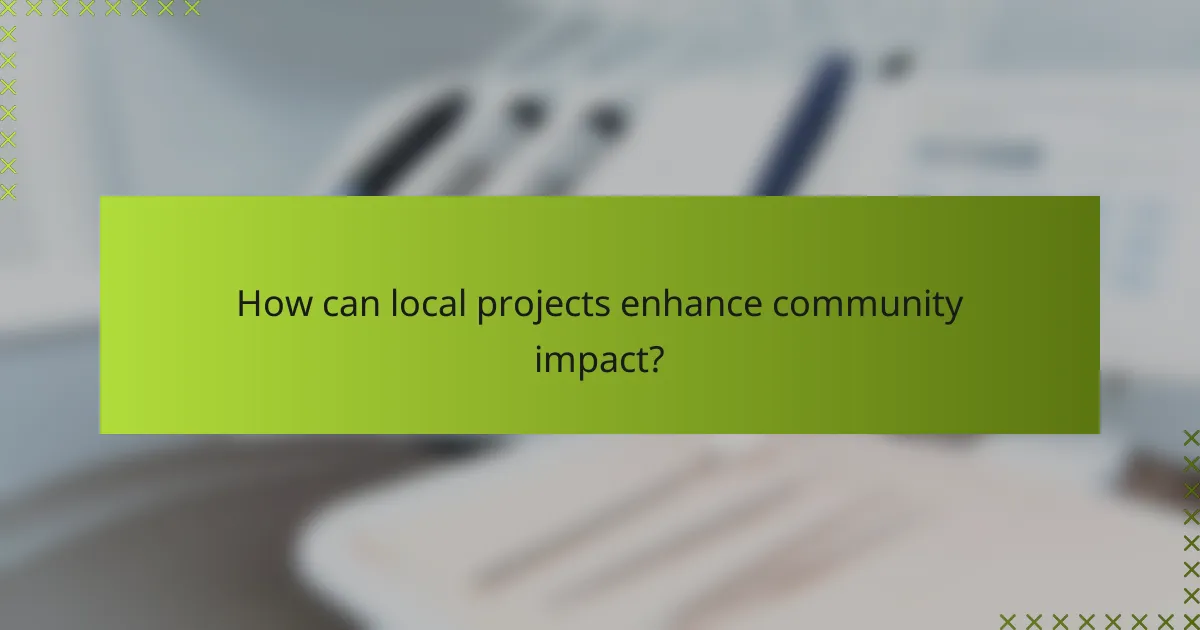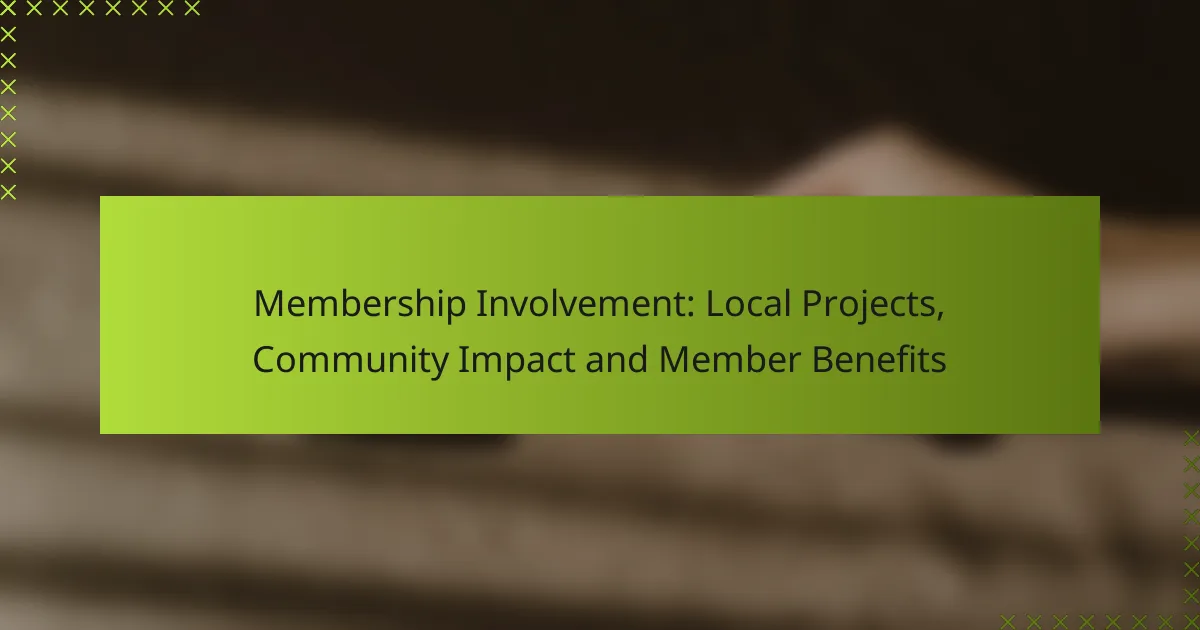Membership involvement in local projects plays a crucial role in enhancing community impact and fostering collaboration among residents. By actively participating, members not only address local needs but also experience personal growth and access exclusive resources, creating a stronger sense of belonging and responsibility within their community.

How can local projects enhance community impact?
Local projects can significantly enhance community impact by fostering collaboration, improving public spaces, and promoting social cohesion. Engaging community members in these initiatives not only addresses local needs but also strengthens the sense of belonging and responsibility among residents.
Community gardens
Community gardens serve as green spaces where residents can grow fruits, vegetables, and flowers together. These gardens promote sustainability, provide fresh produce, and create opportunities for social interaction among neighbors. To start a community garden, gather interested individuals, secure a suitable plot of land, and establish guidelines for maintenance and crop sharing.
Consider organizing workshops on gardening techniques to educate participants and enhance their skills. This can lead to greater yields and a stronger community bond as members share their gardening experiences.
Neighborhood clean-up initiatives
Neighborhood clean-up initiatives focus on improving local environments by removing litter and debris from public spaces. These efforts not only beautify the area but also raise awareness about environmental responsibility. Organizing a clean-up day can be as simple as setting a date, gathering volunteers, and providing necessary supplies like trash bags and gloves.
To maximize participation, promote the event through social media and local community boards. Offering refreshments or small incentives can also encourage more residents to join in and take pride in their surroundings.
Local art installations
Local art installations can transform public spaces and reflect the community’s identity and culture. These projects often involve collaboration between artists and residents, fostering creativity and pride in the local environment. To initiate an art installation, engage local artists and gather input from community members on themes and locations.
Consider applying for grants or seeking sponsorships to fund the project. This not only supports local artists but also enhances community engagement by involving residents in the planning and execution stages.
Volunteer programs
Volunteer programs connect residents with opportunities to contribute to their community through various activities, such as mentoring, tutoring, or assisting local non-profits. These programs can address specific community needs while building networks of support among participants. To launch a volunteer program, identify local organizations that require assistance and create a platform for matching volunteers with opportunities.
Regularly communicate with volunteers to keep them informed and engaged. Recognizing their contributions through events or awards can also help maintain enthusiasm and encourage ongoing participation in community initiatives.

What are the benefits of membership involvement?
Membership involvement offers numerous benefits, including enhanced community engagement, personal growth, and access to exclusive resources. By participating in local projects, members can create a positive impact while enjoying various perks that enrich their experience.
Access to exclusive events
Members gain entry to exclusive events that are not available to the general public. These events often include workshops, seminars, and social gatherings designed to foster community spirit and collaboration.
For example, members may attend annual galas or networking dinners that feature guest speakers and industry leaders. Such events provide valuable insights and opportunities to connect with like-minded individuals.
Networking opportunities
Membership involvement opens doors to extensive networking opportunities. Members can meet professionals from various fields, enhancing their personal and professional connections.
Participating in local projects or events allows members to build relationships that can lead to collaborations, mentorships, and job opportunities. Engaging with a diverse group of individuals can significantly broaden one’s professional network.
Discounts on local services
Members often receive discounts on local services, which can lead to substantial savings. These discounts might include reduced rates at local businesses, restaurants, or recreational facilities.
For instance, a member might enjoy a 10-20% discount at a local gym or receive special pricing on workshops and classes. This not only benefits members financially but also encourages them to support local businesses.
Skill development workshops
Membership involvement frequently includes access to skill development workshops that enhance personal and professional abilities. These workshops cover a range of topics, from leadership training to technical skills.
Members can participate in hands-on sessions that provide practical experience and knowledge applicable to their careers. Regularly attending these workshops can significantly boost one’s skill set and confidence in various areas.

How do local projects foster member engagement?
Local projects significantly enhance member engagement by providing opportunities for participation and collaboration within the community. Members become more invested in initiatives that directly impact their surroundings, leading to a stronger sense of belonging and purpose.
Collaborative decision-making
Collaborative decision-making involves members working together to shape project goals and outcomes. This approach encourages diverse perspectives and fosters a sense of ownership among participants. For example, when planning a community garden, members can vote on plant selections and layout designs, ensuring that everyone’s voice is heard.
To effectively implement collaborative decision-making, establish clear guidelines and facilitate open discussions. Regular meetings and brainstorming sessions can help maintain momentum and keep members engaged. Avoid top-down directives, as they can diminish enthusiasm and participation.
Feedback mechanisms
Feedback mechanisms are essential for gauging member satisfaction and improving project effectiveness. By soliciting input through surveys, suggestion boxes, or community forums, organizations can identify areas for enhancement and address concerns promptly. This responsiveness builds trust and encourages ongoing participation.
Consider using digital tools like online surveys or social media polls to streamline feedback collection. Aim for regular intervals to gather insights, such as after project milestones or events. Ensure that feedback is acknowledged and acted upon, as this reinforces the value of member contributions and fosters a culture of continuous improvement.

What criteria should be considered for selecting local projects?
When selecting local projects, it is essential to consider community needs, member interests, and available skills. These criteria ensure that projects are relevant, engaging, and beneficial for both the community and members involved.
Community needs assessment
A community needs assessment identifies the most pressing issues within a locality. This can involve surveys, focus groups, or public meetings to gather input from residents about their priorities and challenges.
Consider focusing on areas such as education, health, environment, and economic development. For example, if a community expresses a need for improved youth programs, a project could be developed to address that specific gap.
Member interests and skills
Understanding the interests and skills of members is crucial for project selection. Engaging members in projects that align with their passions and expertise increases participation and satisfaction.
For instance, if many members have backgrounds in environmental science, a project focused on sustainability initiatives may be particularly appealing. Conducting a skills inventory can help identify strengths within the membership.

How can members measure the impact of their involvement?
Members can measure the impact of their involvement through various methods that provide insights into community engagement and project effectiveness. By utilizing tools like feedback surveys and outcome reports, members can gain a clearer understanding of how their contributions benefit the community.
Community feedback surveys
Community feedback surveys are essential tools for gauging the perceptions and experiences of local residents regarding projects. These surveys typically include questions about satisfaction, perceived benefits, and suggestions for improvement. Members should aim to distribute these surveys regularly, perhaps quarterly, to capture ongoing sentiments.
When designing surveys, keep questions clear and concise. Consider using a mix of rating scales and open-ended questions to gather both quantitative and qualitative data. For example, asking participants to rate their satisfaction on a scale of 1 to 5 can provide measurable insights, while open-ended questions allow for richer feedback.
Project outcome reports
Project outcome reports summarize the results and impacts of specific initiatives, providing a clear picture of what was achieved. These reports should include key metrics such as participation rates, resources used, and the overall impact on the community. Members can use these reports to assess whether the goals set at the project’s outset were met.
To create effective outcome reports, consider including visual elements like charts or graphs to illustrate data trends. Additionally, highlight success stories or case studies that demonstrate the positive effects of the project on individuals or groups within the community. Regularly sharing these reports can enhance transparency and encourage further member involvement.
